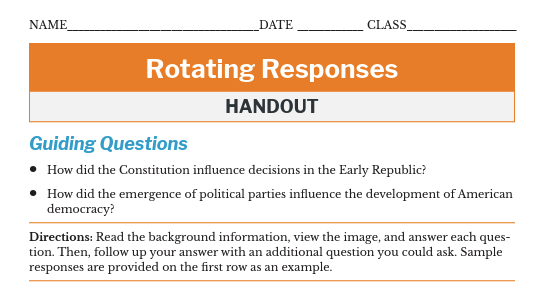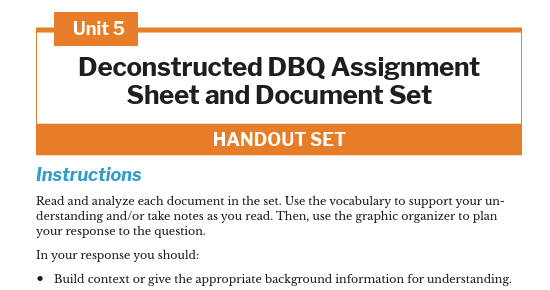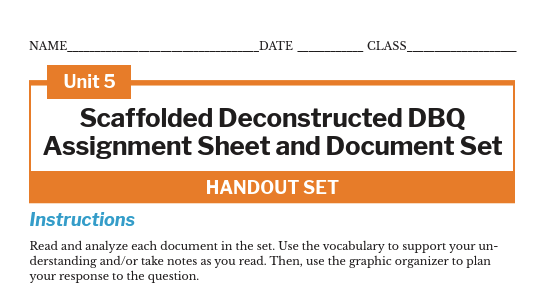
Unit 5: Early Republic Deconstructed DBQ
Lesson Components
Guiding Question
- How did the Constitution influence decisions in the Early Republic?
Objectives
- Students will provide historical context for primary source documents.
- Students will engage in critical thinking to interpret historical perspectives using VIEW (Voice, Intent, Environment, Who).
- Students will develop a thesis statement using historical evidence.
- Students will group sources based on similarities and historical themes.
- Students will develop a thesis that answers the guiding question using evidence from grouped sources.
Student Resources
- Rotating Responses Handout
- Unit 5 Deconstructed DBQ Context, Thesis, Grouping, and VIEW Graphic Organizer
- Document Set (choose 1)
- Deconstructed DBQ Assignment Sheet and Document Set
- Scaffolded Deconstructed DBQ Assignment Sheet and Document Set
- Documents contained within both sets include:
- Document A: Excerpt from Article I Section 8 of the Constitution (1787)
- Document B: Excerpt from Federalist #10 James Madison (1787)
- Document C: Excerpt from George Washington’s First Inaugural Address (1789)
- Document D: Excerpt from Alexander Hamilton’s Opinion on the National Bank (1791)
- Document E: Excerpts from Thomas Jefferson opinion on the National Bank (1791)
- Document F: Excerpt from George Washington’s Farewell Address (1796)
- Document G: Excerpt from the Sedition Act (1798)
- Documents contained within both sets include:
Teacher Resources
Facilitation Notes
- This is a mini-lesson intended to take 45-60 minutes and focus on a specific skill. It is created to accompany the mini-lesson teacher slide deck.
- This lesson is created to build upon the previous Deconstructed DBQ lessons. However, it can be implemented in isolation with additional supports. Modify using the scaffolding notes to fit your classroom.
- This mini-lesson introduces the new skill of providing context which will be built on in Unit 7: American Expansion with the introduction of the skill providing evidence.
Engage
Rotating Responses
- Transition: Distribute the Rotating Responses Handout.
- Instruct students to work independently on the handout to prepare for the activity.
- Students will read the background information and carefully view the image.
- Then, they will answer the questions and craft a follow-up question for each.
Scaffolding note: Providing a time limit for this independent work can be helpful. The handout could also be assigned for homework the day before.
- When time has elapsed, or students have completed the handout, assign a number from 1 to 4 for each student. This will create groups of 4, with each student having an assigned number.
- Then use one group, or volunteers, to conduct a practice round demonstration before allowing groups to discuss on their own. Below are instructions on how to use the rotating responses. For a visual interpretation of this activity, see the slide deck.
Scaffolding note: If this is your first time using the Rotating Responses activity, you may want to do the whole activity as a demonstration with one group conducting the activity. Adapt the method to fit your students.
- Each student in the group is assigned a role in the discussion.
- Student 1: Reads the question
- Student 2: Answers the question
- Student 3: Provides praise and encouragement
- Student 4: Asks a follow-up question
- All students then discuss the follow-up question informally
- Students use their roles to answer the first question, then rotate for the second question, continuing until they answer all four questions and have had all four roles.
- Use the slide deck to support this activity, it contains a slide that guides students through each round of the activity.
- Optional Activity: Discussion Question- How did the emergence of political parties influence the development of American democracy?
Introduce the Deconstructed DBQ
- Tell students: “Today we will investigate how the Constitution influenced decisions in the Early Republic by working with primary source excerpts.”
- Distribute the deconstructed DBQ document set and allow students 3-5 minutes to skim them and ask any questions they may have.
Scaffolding note: There are 7 documents in this primary source set. Scale the set to fit the needs of your students if needed. 3-4 documents is a good place to start.
Teacher note: There are slides in the teacher deck to facilitate a whole-group discussion or reading if your students need more support.
Explore
Grouping Review
- Transition: Distribute the Unit 5 Graphic Organizer.
- Students group documents based on shared themes, common attributes, constitutional principles (For example: separation of powers, individual rights), or any other categories they decide.
- Encourage students to justify their groupings in writing using evidence from the documents.
- Sample groupings:
- Group 1- Federalist Vision: Strong National Government
- Document A- Article I, Section 8
- Document B- Federalist #10
- Document D- Hamilton’s Opinion on the National Bank
- Document F- Washington’s Farewell Address
- Group 2- Democratic-Republican Vision: Powers of the States and Limited Government
- Document E- Jefferson’s Opinion on the National Bank
- Document G- Sedition Act
- Group 1- Federalist Vision: Strong National Government
Teacher note: Additional support for this skill and an example are available in the teacher slide deck.
Providing Context
- Tell students: “Context is: The “who, what, when, where, why, and how” of the document. It explains the world around the source, helping the reader understand its significance within the time period. It should also tie the source to the DBQ question.”
- Students then use the graphic organizer to collect and store information about 3-4 sources from the document set.
- Students can use their prior knowledge, the source, or research to complete the organizer.
- When students complete the organizer, they will write a context summary in the bottom box. The summary should cover one document that they analyzed, explaining its significance and connecting it to the DBQ question.
- For example: Document A: Article I, Section 8 of the Constitution was written in 1787. It establishes the Necessary and Proper Clause, which defines the powers of congress and sets up a strong central government.
Scaffolding note: If needed, complete one row of the context organizer together with your students before releasing them to complete the rest of the organizer independently.
VIEW Document Analysis Review
- Prompt students to continue on to the next organizer on the same page.
- Students should use the same documents they analyzed in the context organizer.
- Ask them to fill in the E-Environment row of the organizer first, using what they put in the context organizer.
- Then students should fill in at least two more boxes of the organizer for each of their 3-4 documents.
- Use the review slides if needed to refresh students on the purpose of document analysis, provide thought prompts, and preview the organizer.
Thesis Writing & Organizer Completion
- Students use their grouped sources to draft a thesis that answers the guiding question.
- Example structure:
- The Constitution influenced decisions in the early republic like [event 1] and [event 2].
- Example:
- The Constitution’s broad language on federal power influenced early debates over its interpretation, as seen in the conflict between Hamilton and Jefferson over the National Bank.
- Students write their thesis on the graphic organizer and complete any remaining sections of the Deconstructed DBQ organizer.
Teacher note: Review and example slides are available in the teacher slide deck on hidden slides if re-teaching or specific skill instruction is needed. There are also additional thesis examples in the notes of the slides.
Scaffolding note: Students needing more challenge could be given the opportunity to turn their Deconstructed DBQ into a written response at this stage. This could be a paragraph, or multiple paragraph essay depending on the amount of challenge needed.
Assess
- Students complete their graphic organizer and submit for assessment.
- Collect organizers to assess whether students:
- provided context surrounding several documents.
- accurately analyzed sources using VIEW.
- grouped sources based on logical connections.
- created a clear, defensible thesis.
Reflect
Peer Review
- Have students share their organizers with a partner.
- Using the prompts from the slide deck, ask students to review their partner’s organizer.
- Depending on your time, ask students to focus on one aspect or review all three.
Scaffolding note: The peer review could be completed before students submit their graphic organizers for assessment as a formative assessment.
- Optional Debrief Questions:
- How does analyzing the context surrounding sources help shape your thesis?
- What challenges did you face when grouping the sources?
- How do you create a thesis that answers the question fully, without becoming too long?



